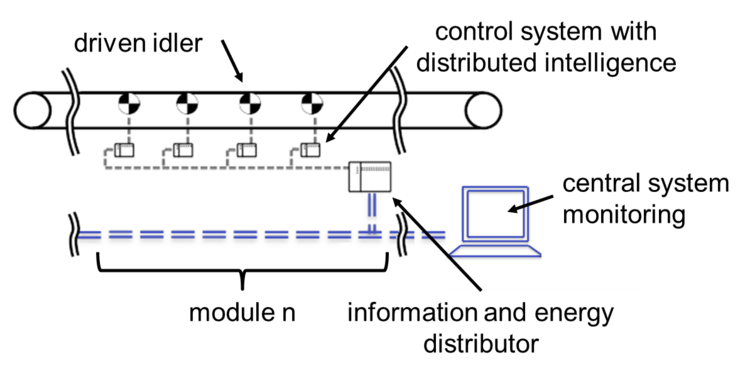New drive concept for belt conveyor systems on the basis of directly driven load-bearing rollers

| Year: | 2016 |
| Date: | 30-04-18 |
| Funding: | AIF, IFL |
| Duration: | 05/2016 – 04/2018 |
| Is Finished: | yes |
In a conventional belt conveyor system, the endless closed-loop belt usually runs via return roller and is supported by several rollers to carry the weight of the belt, and to maintain the shape of the belt. The front return roller serves as a head drive of the system. During a belt rotation a rising local traction power affects the belt due to the one-sided application of force.
In the area of bulk goods conveying there is a sustained trend toward steadily increasing mass flows and lengthening conveyors. This is associated with an increase in the maximum belt traction, which is a limiting factor in the selection of the belt assembly. Intermediate drives can be used to reduce the maximum belt traction. This results in an improved course of the force distribution. Intermediate drives are so far realized by means of driving straps or additional return rollers with the belt wound around them. However, these lead to high investment costs or a reduced life span.
The definition of the technical requirements with regard to support roller geometry, drive performance and transmitting power is followed by the concept of a drive which is able to power motor-driven rollers. There is a distinction between motors built into the support rollers and motors that are attached externally to the support rollers. The design of the respective control represents a substantial part of research. In addition to ensuring the basic functions, economic aspects and the possibility of low-cost extension must be provided. A functional model is built from the drive and control concept, which is first tested as “hardware in the loop” in a testbed adapted in the research institute. This is where the functionality of the functional model is to be optimized through selective reproduction of a practical system. In the last step, several functional models are made and the operation carried out on the testbed. The respective findings are to extend the current state of knowledge and to provide the basis for the construction of belt conveyor systems by means of powered supporting rollers in practice. For this purpose, individual support roller garlands are replaced by a corresponding support roller with directly connected motor at regular intervals. The individual drive controls are to have a locally distributed, local intelligence, so that a superordinate, complex control system can be omitted.
These decentralized control systems can be arranged according to organizational and/or functional aspects, so that the resulting functional emergence from the combination of several controllers can be used for the management of complex control operations.
The aim of this research project is the study, implementation and validation of a suitable concept to move a conveyor belt only by powered rollers. For belt conveyors with head drive the maximum length of the conveyor is determined by the selected conveyor belt and the maximum occurring belt traction in the system. With a drive by means of powered supporting rollers, the force application is distributed, so that the conveyor length is initially arbitrarily expandable. Besides the development of a concept for a powered supporting roller, the main focus is on the development and implementation of a control concept and simulation-based evaluation of operability by powered supporting rollers.




















